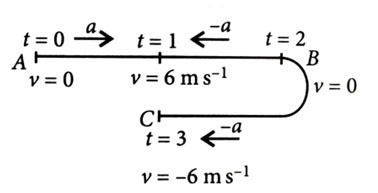Topic Question Set
Q 1
:
An electron falls from rest through a vertical distance h in a uniform and vertically upward directed electric field E. The direction of electric field is now reversed, keeping its magnitude the same. A proton is allowed to fall from rest in it through the same vertical distance h. The time of fall of the electron, in comparison to the time of fall of the proton is [2018]
smaller
5 times greater
10 times greater
equal
(1)
Force experienced by a charged particle in an electric field,
As
...(i)
As electron and proton both fall from the same height at rest, then initial velocity = 0
From
As electron has smaller mass, it will take a smaller time.
Q 2
:
A toy car with charge moves on a frictionless horizontal plane surface under the influence of a uniform electric field . Due to the force , its velocity increases from 0 to 6 m in one second duration. At that instant, the direction of the field is reversed. The car continues to move for two more seconds under the influence of this field. The average velocity and the average speed of the toy car between 0 to 3 seconds are respectively [2018]
2 m , 4 m
1 m , 3 m
1 m , 3.5 m
1.5 m , 3 m
(2)

Acceleration,
For to
For to
For to ,
Total displacement
Average velocity
Total distance travelled = 9 m
Average speed

